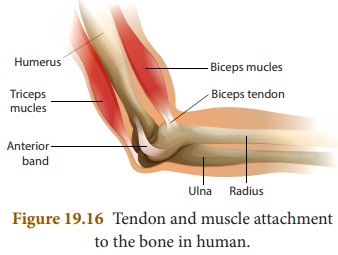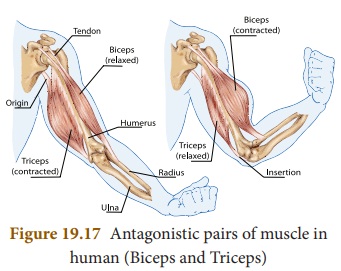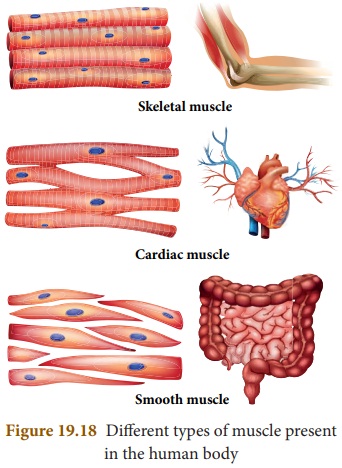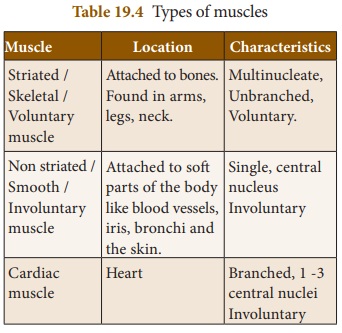Movements in Animals | Chapter 19 | 8th Science - Muscles | 8th Science : Chapter 19 : Movements in Animals
Chapter: 8th Science : Chapter 19 : Movements in Animals
Muscles
Muscles
The muscles in the body provide the
means of all movements. They cover the skeletal framework and also give shape
to the body. Muscles help to maintain body posture while sitting, standing or
walking. Most muscles are long bundles of contractiletissue. Each muscle
usually has two ends - a fixed end
where the muscle originates and a
movable end which pulls some other part. This movable end is drawn out to form a tough structure the tendon which is attached to the bone.
When stimulated by a nerve the muscle contracts to become shorter and thicker
and thus it pulls the bone at the movable end. Muscles can only contract and
relax, they cannot lengthen.

• There are muscles in
the root of your hair that give you goose bumps.
• It takes 17 muscles
to smile and 42 muscles to frown.
• The hardest working
muscle is in eye.

Muscles often work in pairs which
work against each other. These are called antagonistic pairs. The muscles in
the upper arm control the bending and straightening of the arm. The two
muscles, the biceps and triceps are working against each other. When the biceps
contracts the lower arm is raised and the arm bends. In this position the
triceps muscle is relaxed. To straighten the arm the reverse happens. The
triceps contracts straightening the arm, while the biceps relaxes. Antagonistic
muscles can be found all over the body. In the iris of the eye there are two
sets of muscle. There are radial muscles which radiate from the pupil like
spokes of a bicycle and there are circular muscles. The radial muscles make the
pupil of the eye wider, while the circular muscles make the pupil smaller.
Activity 5
Measure the size of
your biceps and also ask your friends to do. Take turns lifting a bottle with
water as many times as you can. Record the number of lifts each student was
able to do. Compare each pair’s results with the rest of the class and
determine whether those with larger bisceps were able to do more lifts.
Types of Muscles
Muscles found in higher vertebrates
are of three types:
* Striated or skeletal muscles or voluntary
muscles.
* Unstriated or smooth muscles or
involuntary muscles
* Cardiac muscles


Coordination of
Muscles
Most actions in our body like
standing, walking, running, playing tennis etc. , require combined action of
several muscles. To a great extent the muscles have to be coordinated for a
particular kind of movement.
Muscles move body parts by
contracting and then relaxing. Muscles can pull bones, but they can't push them
back to the original position. So they work in pairs of flexors and extensors.
The flexor contracts to bend a limb at a joint. Then, when the movement is
completed, the flexor relaxes and the extensor contracts to extend or
straighten the limb at the same joint. For example, the biceps muscle, in the
front of the upper arm, is a flexor, and the triceps, at the back of the upper
arm, is an extensor. When you bend your elbow, the biceps contracts. Then the
biceps relaxes and the triceps contracts to straighten the elbow.
Related Topics